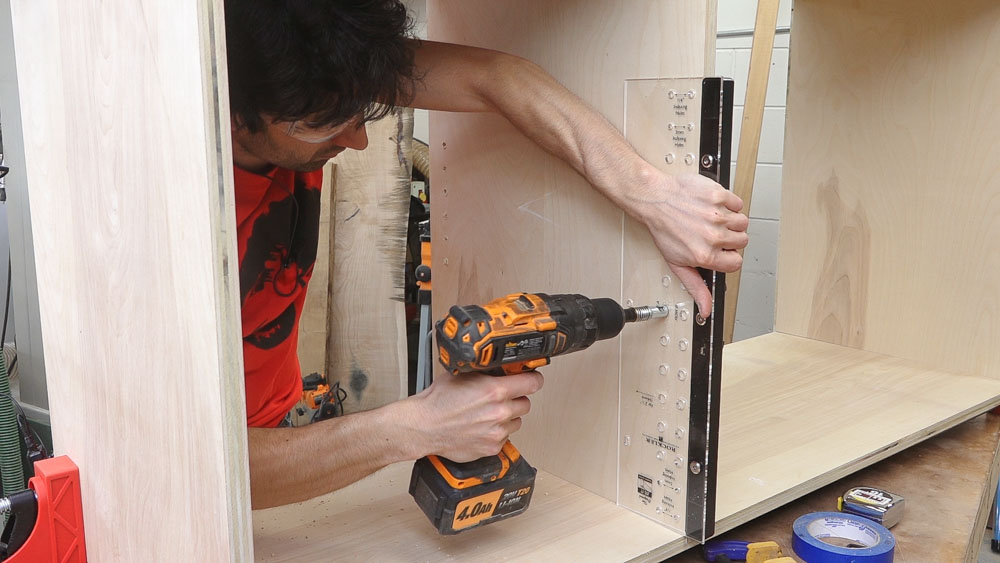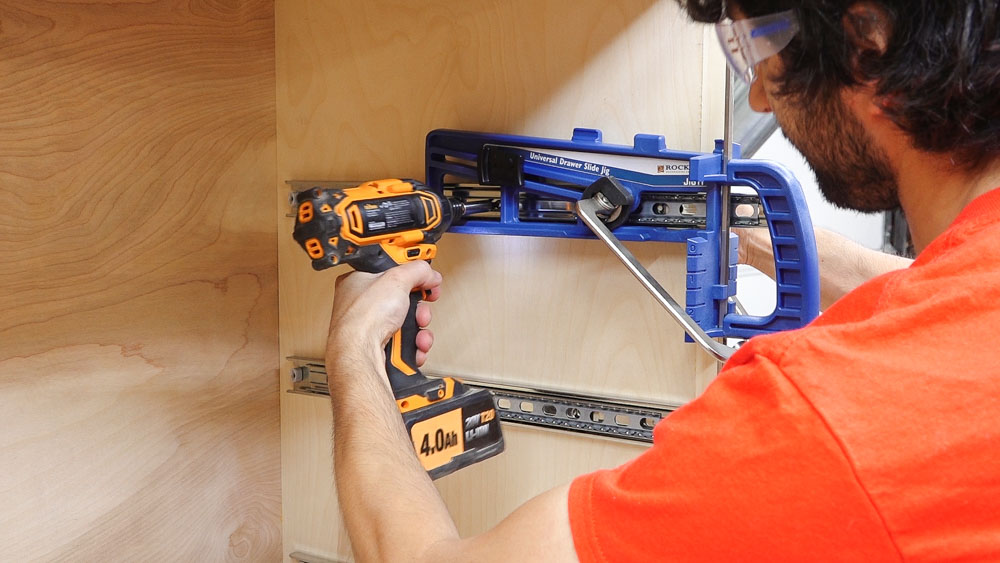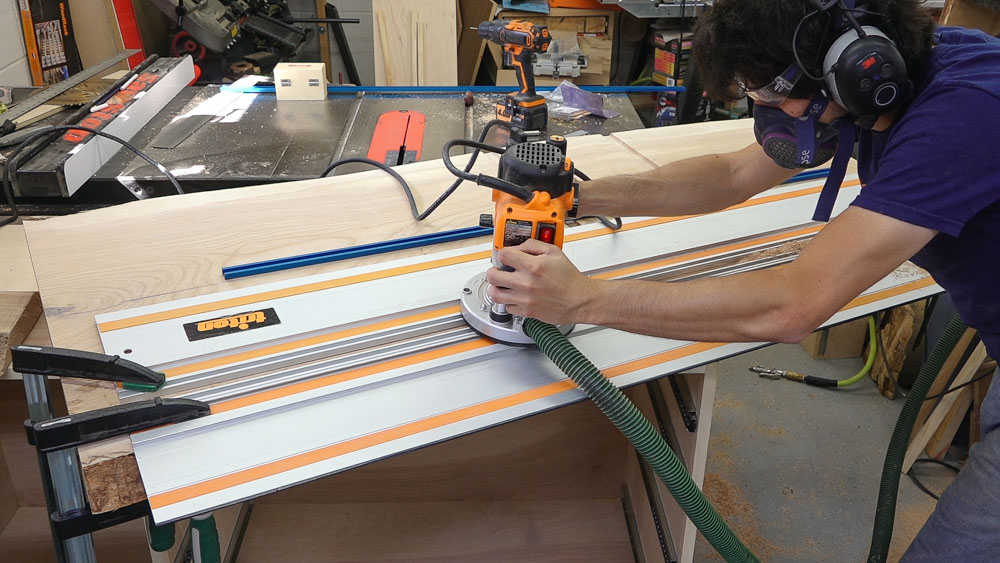
Kitchen Island, Barn Power – March 2024 Update
Welcome to my shop! This is a quick update to let you know what I’ve been up to. This big chunky thing is the leg
I’ve been without a dedicated outfeed table for my tablesaw for almost two years now. When I got the SawStop back in Sept 2016, I sold my old saw and sent the outfeed table along with it. I’ve had the intention of knocking out this project ever since.
Big thank you to Rockler Woodworking and Hardware for sponsoring this build. They have supplied all the hardware, jigs, and accessories used in this project. There are links at the end of the posts to everything that I used for this project.
I wanted this project to be somewhat unique and I had never seen anyone use a live edge slab for the top. I figured that a hardwood top would make this have even more of a workbench feeling. Essentially the look you get with a butcher block top but taken to the next level.

I was really happy with the overall size and design of my previous outfeed table so I’m going to be pretty closely replicating it: 5′ long and 24″ deep. I have a stack of 10/4 slabs from a short ash log that I cut a few years ago and recently used the bookmatched slab for a waterfall table. Two slabs down, six to go!

This slab was a little longer than my ideal finished length so I trimmed it closer to final length. On one end I removed part of the felling hinge and the other had some rot that I wanted to trim back.

Next up is some initial epoxy filling. I like to fill as much as I can before surfacing the slab that way all the excess epoxy will be removed during surfacing. It’s not as necessary to keep things neat at this point since any excess will be removed. I’m using West System epoxy with a few drop of Transtint medium brown mixed it.

The slab is stabilized on my flat assembly table using some shims and the router sled is used to flatten the slab. I wanted to preserve as much thickness as I could because I wanted a substantial look for the outfeed table top so I flattened most of the bottom but left a low area. This isn’t a huge deal since the majority of the slab will still contact the cabinet.

Flipping the slab over and working on the top, I similarly stopped making passes with the router before the entire surface was cleaned up. This time I was more interested in the look of having some rough sawn marks still in the slab. This slab started at 10/4 and finished right at 2″ thick.

Now it’s on to making the cabinet. I picked up a sheet of 3/4″ plywood which will become the cabinet’s carcass and two sheets of 1/2″ plywood which will become the cabinet back and the drawers. I break down the sheets into strips in my driveway with a tracksaw. I’ll set the 1/2″ ply aside for now and focus on the 3/4″ ply for the case.

I’ll further break down the strips and cut each part to final size. Similar pieces like the sides and top & bottom, I’ll clamp together and cut at the same time so they’ll be exactly the same.

The joinery for the case will be rabbets and dados. I’ve set the dado stack to protrude past a sacrificial fence by the thickness of the plywood and I’ve set the blade height to 1/2″ high.

Once the rabbets in the top and bottom of the sides have been cut, I’ll switch the set up a bit to cut the rabbet along the back of each piece for the 1/2″ plywood back. Lastly, the dados for the divider are cut into the top and bottom.

I didn’t have enough of the 3/4″ plywood left to make up the divider but I did have a strip that was twice as long and half as wide as I needed so I cut it in half and glued the two halves together to make up the width that I needed.

The case can be test fit together and the back panel can be cut to size. Before gluing up the case, I can drill the shelf pin holes in the smaller cavity which will receive a shelf.

Now the case can be glued up. I didn’t have enough longer clamps so I flipped the bodies on a pair of shorter ones and clamped their heads together. Similarly, I didn’t have a clamp long enough to run corner to corner to pull the case into square so I used a ratchet strap.

Next I could start working on the edge banding. I used a boring piece of boxelder for these strips. The strips are planed down to the thickness of the plywood and are cut 3/4″ wide. They’re cut to fit and glued to the case.

With the case flipped upside down, I can add the leveling feet and casters. This will be a primarily stationary cabinet so the leveling feet will provide a lot of stability and make it very easy to get the outfeed table coplaner with the table saw. If I ever have to move this cabinet, the leveling feet can be raised, dropping the cabinet onto the casters. I had this same set up on my old outfeed table. I moved it maybe every other year for whatever reason but every time I did, I was glad I had added the casters. I also have this set up on my assembly table. I have yet to move it in the 6 years I’ve had it sitting in my shop but the day I have to, I’ll be happy to have the casters under there. While the cabinet is upside down, I can also drill the holes through the top which will connect the slab top to the cabinet.

Next up are the drawers. I can work the 1/2″ plywood down to the final size of all the drawer parts and cut the joinery. The drawers will be joined exactly like the case. The front and back receive the rabbet so it’s very easy to get the drawer box sized correctly when using drawer slides. Once the fronts are cut to length, they can be placed into the cabinet next to the drawer slides and the fit can be evaluated. This saves any headache of making a drawer too wide or too narrow to work with the drawer hardware.

Before I glue up the drawer boxes, I’ll install the slides into the case.

Assbembly on the drawer boxes is straight forward. All the rabbets get glue and I’ll shoot some pin nails to keep everything together. I’ll immediately mount the drawer into the case to dry. This makes sure that the drawer box has the same geometry as the opening and it also gives them somewhere to go while the glue dries instead of spreading them out all over the shop.

I’ll work through each drawer box, assembling and installing it into the case.

Next up are the drawer fronts. I used box elder for these as well. The stock is milled to 3/4″ thick and ripped to the right width to fit the drawer box when using 1/8″ spacers. One end is cut square and gapped. The other end is marked and cut to final length.

The drawer front is clamped to the box and secured with 6 screws.

That takes care of the cabinet so it’s on to the slab top. I’ll transfer the hole locations from the cabinet top to the slab top, and drill and tap the holes in the top for 1/4-20 bolts. I also cut the top to final length at this time. I got it aligned on the cabinet and marked out where the cabinet was on the slab. I made my final cuts parallel to this line so the overhang would be straight.

The top needs dados cut into it for clearance of things in the table saw’s miter slots. I transferred the locations of the slots onto the slab and over sized them by 1/4″ in width. The dados are cut with a router and straight edge.

I also wanted to add a few lengths of T track to the top. This would give the top a bit more versatility. I laid two lengths of track out on the top in exactly the position I wanted them to be and temporarily screwed them down. This will allow me to temporarily remove one and the other will not move while I set up the guides for the router.

With one track still screwed to the top, I’ll butt two strightedges up to the track and clamp them down. The track can then be unscrewed and a pattern bit can be used to cut the groove for the track. Since the guides butted up to the track, the resulting groove will be perfectly sized in width for the track.

With all the groove cut for the track, it can be installed and the shorter pieces can be cut to length.

I did end up deciding to apply finish to this project (something I would skip for shop furniture), so everything was disassembled while I applied two coats of finish. I wasn’t interested in building a finish, I just wanted to bring out the color.


Done! It’s so nice to have one of these again. I’ve really missed it. The functionality of parts not falling off the back of the saw is great to have again and even more importantly in my shop, having the storage space back is huge!
[links are affiliate links]
Triton Router: http://amzn.to/2hXj5AC
Triton Tracksaw: http://amzn.to/2f2P85l
Table Saw: http://amzn.to/2hXj5AC
Metal Bandsaw: http://amzn.to/2shAUUX
Beam Saw: https://amzn.to/2Kh9yTh
Heavy Duty Lifting Leveler: http://shrsl.com/10ofs
3″ Heavy-Duty Polyurethane Casters: http://shrsl.com/10oft
Rockler Universal Drawer Slide Jig: http://shrsl.com/10ofu
Rockler 4 Ft. Universal T-Track: http://shrsl.com/10ofv
Rockler T-Track Intersection Kit: http://shrsl.com/10ofw
JIG IT® Shelving Jig w/Self-Centering Bit: http://shrsl.com/10ofy
Rockler 6″ Auto-Adjust Jig Clamp: http://shrsl.com/10qhf
Rockler Bandy Clamps: http://shrsl.com/10qhd
Rockler Auto-Lock T-Track Hold Down: http://shrsl.com/10qhk
Rockler T-Track Inline Cam Clamp: http://shrsl.com/10qho
West System Epoxy Resin (Gallon): http://amzn.to/25TYH7y
West System Epoxy Slow Hardener (Quart): http://amzn.to/25TYKAr
West System Metering Pumps: http://amzn.to/1qicuEr
Transtint Medium Brown: http://amzn.to/23nL4Ps
Finish: http://amzn.to/2FFWlVG
Dust Mask: http://amzn.to/2y8dl1m
Hearing Protection: http://amzn.to/2yQ0sa3
More stuff on my Amazon page: https://www.amazon.com/shop/matthewcremona


Welcome to my shop! This is a quick update to let you know what I’ve been up to. This big chunky thing is the leg

Welcome back to the home renovation. This time I’m going to be working on the kitchen island. Here is a small model of the island.

Welcome back to our home renovation. Today I am going to be working on this wall. It needs some upper cabinets and the surround for
2 Responses
FYI the affiliate links for the Triton Router and the Table Saw are the same link.
Thanks for all you’re doing!
Thanks for the heads up!